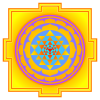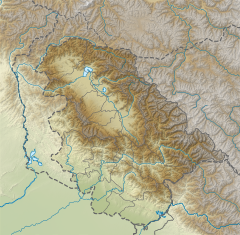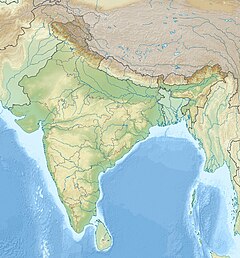Vaishno Devi Temple
| Vaishno Devi Temple | |
|---|---|
 View of Shri Mata Vaishno Devi Bhavan surrounded by Trikuta Hills | |
| Religion | |
| Affiliation | Hinduism |
| District | Reasi |
| Deity | Vaishno Devi |
| Festivals | Navaratri, Diwali, New Year |
| Governing body | Shri Mata Vaishno Devi Shrine Board |
| Location | |
| Location | Jammu and Kashmir |
| Country | |
| Geographic coordinates | 33°01′48″N 74°56′54″E / 33.0299°N 74.9482°E |
| Architecture | |
| Type | Cave Temple |
| Completed | 0028 Vikram Samvat |
| Specifications | |
| Temple(s) | 4 |
| Elevation | 1,584.96 m (5,200 ft) |
| Website | |
| maavaishnodevi.org | |
 | |
| Part of a series on |
| Shaktism |
|---|
 |
|
|
Vaishno Devi Temple, also known as the Shri Mata Vaishno Devi Temple and Vaishno Devi Bhavan, is a Hindu temple located in Katra, Jammu and Kashmir, dedicated to Vaishno Devi, a manifestation of Mahakali, Mahalakshmi, and Mahasarasvati.[1][2][3][4] It is located on the Trikuta mountain at 5,000 feet / 1,500 meters elevation.[5] The Shakti tradition considers it to be a Shakti Pitha.[6] The temple is governed by the Shri Mata Vaishno Devi Shrine Board (SMVDSB) and has been chaired by the Governor of Jammu and Kashmir since August 1986.[7]
It is one of the most popular Hindu pilgrimage sites in north India, with millions of devotees visiting the temple annually.[8] In 2018, the Vaishno Devi shrine reported that it had received 8.5 million pilgrims that year.[9]
History
[edit]Although the Vaishno Devi temple is now the most popular Devi shrine in the region, its popularity is relatively recent. In 1971, when Inderjit Bhardwaj did a study of Devi shrines in the Siwalik mountains, he did not mention the Vaishno Devi temple as particularly important. Its popularity increased rapidly after an expansion was done in 1976 so that it could accommodate up to 5,000 visitors per day. By 1981, annual visitors to the shrine were about 900,000; by the early 1990s, the number had increased to over 3 million, and the Vaishno Devi temple had become by far the most popular Devi temple in the region. By 2007, the annual number of pilgrims was about 7.5 million. In June 2007, in order to reduce congestion and improve security, the Shrine Board reduced the limit on the number of visitors allowed per month.[10]: 110, 16
The Vaishno Devi temple was in existence by 1846, when Maharaja Gulab Singh established the Dharmarth Trust to manage several temples in his territory; the Vaishno Devi temple was part of this trust. The trust remained in the hands of Gulab Singh's descendants after independence, and his descendant Karan Singh was responsible for administering the temple as the hereditary trustee until 1986, when Jagmohan, then governor of Jammu and Kashmir, passed legislation transferring control of the Vaishno Devi temple from the Dharmarth Trust and the hereditary priests to a separate Shrine Board.[10]: 114–5
Legends
[edit]The temple, at a height of 1,585 metres (5,200 ft) is 12 km from Katra on Trikuta hill. It is about 61 km from Jammu city.[11][12] A geological study of the Holy Cave has indicated its age to be nearly a million years. There is also a mention of the Trikuta hill in Rigveda, the place where the temple is located.[13]
The Mahabharata, which gives the account of the Pandavas and the Kurukshetra War, does mention the worship of goddess Vaishno Devi. Before the Kurukshetra War Arjuna is said to have worshipped Durga by the advice of Lord Krishna for the blessings. Pleased by his devotion, Mother Goddess appeared in front of him in the form of Vaishno Devi. When goddess appeared, Arjuna started praising her with a stotra, in which a Shloka goes by saying ‘ Jambookatak Chityaishu Nityam Sannihitalaye ’, which means ‘you who always dwell in the temple on the slope of the mountain in Jambhu’ — probably referring to the present day Jammu.[14] Former Governor of Jammu and Kashmir Jagmohan says, "the Mata Vaishno Devi shrine is an ancient one whose antiquity is pre-Mahabharathan, Lord Krishna is believed to have advised Arjuna to go up in the hills of 'Jambhu' and seek the blessings of Vaishno Devi before taking up arms in the battlefield. 'Jambhu' is identified with present-day Jammu. Arjuna while worshipping Vaishno Devi, calls her highest yogi who is free from decrepitude and decay, who is the Mother of the Vedas and the Science of Vedanta and who is giver of Victory and personification of victory itself".[15] It is also generally believed that the Pandavas were the first to build the temples at Kol Kandoli and Bhawan in reverence and gratitude for the Mother Goddess. On a mountain, just adjacent to the Trikuta Mountain and overlooking the Holy Cave are five stone structures, which are believed to be the rock symbols of the five Pandavas.[16][17][18]
- The appearance of Vaishno Devi to Shridhar and the story of Bhairon Nath

It is said that Bhairon Nath, a famous Hindu Tantric, saw the young Vaishno Devi at an agricultural fair and fell madly in lusty love with her. Vaishno Devi fled into Trikuta hills to escape his amorous advances, later she turned into her original form of Durga and cut off his head with her sword in a cave.[19][20]
According to author Manohar Sajnani, some legends hold that the original abode of Vaishno Devi was Ardh Kunwari, a place about 6 km[21] between Katra town and the cave.
Deities
[edit]
The three icons — Mahakali, Mahalakshmi and Mahasaraswati, all images of Vaishno Devi are worshipped at the temple. The feet of the icons are washed by the water brought from the perennial flowing river Banganga.[22]
Worship
[edit]Author Abha Chauhan identifies Vaishno Devi as the incarnation of Durga.[23] Author Pintchman identifies with great goddess Mahadevi and says Vaishno Devi contains all powers and is associated with the entire creation as Mahadevi.[24] Author Pintchman also says that, "Pilgrims identify Vaishno Devi with Durga — whome Dogras (and others) also name Seranwali, "the Lion-rider"— more than with any other goddess".[24] The temple is sacred to both Hindus and Sikhs. Many prominent saints such as Swami Vivekananda have visited the temple.[25]
The temple receives an estimated annual $16 million according to some authors[26] and has received over 1,800 kgs of gold, 4,700 kilos of silver, and ₹2,000 crore (US$230 million) cash in the last two decades (2000-2020) as donation.[27]
Festivals
[edit]The most prominent festivals held at Vaishno Devi Temple are Navaratri, a nine nights festival celebrating Devi's victory over evil demons and Diwali, a festival of lights symbolizing the victory of light over darkness, good over evil, and knowledge over ignorance.[28][29][30]
The Navaratri festival is a festival celebrated during the month of Ashvin, which typically falls in the Gregorian months of September and October.[31] The festival lasts for nine nights (ten days); artists from all over the country perform during the function at Vaishno Devi darbar. Due to COVID-19 pandemic Shrine Board also started delivering Prasāda for the devotees who are unable to come to the temple by collaborating with Postal Department of India.[32]
Devotees of all faiths and all schools of thought of Hinduism visit the Vaishno Devi Temple.[33]
On 1 January 2022, 12 people were killed and 16 were left injured after a stampede occurred while thousands of pilgrims rushed to the mandir on the first day of the new year.[34][35][36]
Administration and visit
[edit]The Vaishno Devi Temple was included in the Jammu and Kashmir Shri Mata Vaishno Devi Shrine Act No. XVI/1988 and also part of Article 26 of the Constitution of India.[37] The board name is Shri Mata Vaishno devi Shrine Board. There are nine members in the board; all are nominated by the Government of Jammu and Kashmir, particularly by Governor of Jammu and Kashmir. The Governor of Jammu and Kashmir is the ex-officio chairman of the board.[38] In 1991, Shri Mata Vaishno devi Shrine Board management also took the control of Shiv Khori, a famous Shiva temple.[39]

Shrine Board have also constructed guest houses such as Vaishnavi Dham, Saraswati Dham, Kalika Dham, Niharika Yatri Niwas, Shakti Bhawan and Ashirwad Bhawan near the Railway station and Bus stand at Katra.[40]
During the winter season from the month of December to January the Vaishno Devi Temple is covered with snow.[41][42]
See also
[edit]- Martand Sun Temple
- Patnitop
- Amarnath
- Gulmarg
- Aharbal
- Gangbal
- Raghunath Temple
- Pahalgam
- Sharada Peeth
- Jammu
- Avantiswami Temple
References
[edit]- ^ Sciences, International Union of Anthropological and Ethnological (2011). Holy Places & Pilgrimages: Essays on India. Shubhi Publications. ISBN 978-81-8290-228-2.
- ^ Rindani, Kirit (2016). Indian Himalaya: Story of a 100 Visits. Partridge Publishing. p. 47. ISBN 978-1482858860.
- ^ S. S. Negi (1998). Discovering the Himalaya, Volume 1. Indus Publishing. p. 429. ISBN 9788173870798.
- ^ Kuldip Singh Gulia (2007). Mountains of the God. Gyan Publishing House. p. 15. ISBN 9788182054202.
- ^ Chaudhary, Poonam (2002), Religious terrorism -the latest threat (Juxtaposition of Jammu's Heritage - Living and vibrant versus dead and decaying) (PDF), Madrid: Comité Nacional Español del ICOMOS, pp. 311–314, retrieved 19 February 2024
- ^ "Famous Durga temples in India for religiously inclined souls". Times of India. 5 April 2019.
- ^ "Facts about Shri Mata Vaishno Devi Shrine Board". SMVDSB Official Site. Archived from the original on 7 March 2023. Retrieved 30 June 2022.
- ^ "Vaishno Devi pilgrim footfall in 2019 lowest in 3 years: Shrine Board". Business Standard. 2 January 2020.
- ^ "Vaishno Devi likely to receive 8.5 mn pilgrims by Dec 31; highest in 5 yrs". Business Standard. 29 December 2018.
- ^ a b Foster, Georgana; Stoddard, Robert (2010). "Vaishno Devi, the Most Famous Goddess Shrine in the Siwāliks". In Singh, Rana P. B. (ed.). Sacred Geography of Goddesses in South Asia. Newcastle upon Tyne: Cambridge Scholars. pp. 109–24. Retrieved 31 May 2024.
- ^ Aggarwal, J. C.; Agrawal, S. P. (1995). Modern History of Jammu and Kashmir: Ancient times to Shimla Agreement. Concept Publishing Company. p. 10. ISBN 978-8170225560.
- ^ "Six toughest treks that pilgrims undertake". The Economic Times. 23 June 2015.
- ^ "Shri Mata Vaishno Devi Shrine Board :: Holy Shrine :: History of the Holy Shrine :: History of the Holy Shrine". Archived from the original on 8 April 2023. Retrieved 19 June 2022.
- ^ "Sri Mata Vaishno Devi Shrine". Times of India. 15 March 2018.
- ^ Jagmohan (2005). Soul and Structure of Governance in India. Allied Publishers. p. 334. ISBN 978-8177648317.
- ^ "President visits Vaishno Devi, inaugurates two new facilities". India Today. 2 September 2014.
- ^ "Maiden master plan for Vaishnodevi shrine area". The Economic Times. 12 April 2017. Retrieved 25 December 2018.
- ^ "Vaishno Devi-Bhairon Mandir ropeway service starts from today". The Times of India. Retrieved 25 December 2018.
- ^ Journal of Religious Studies, Volume 14. Department of Religious Studies, Punjabi University. 1986. p. 56.
- ^ Pintchman 2001, p. 60.
- ^ Rajput, Raghav (21 November 2023). ""Vaishno Mata" - Vaishno Mata: Who Is Simrat Kour In 'Gadar 2'". mygeniusbrand.com (in Hindi). Retrieved 21 November 2023.
- ^ Aggarwal, J. C.; Agrawal, S. P. (1995). Modern History of Jammu and Kashmir: Ancient times to Shimla Agreement. Concept Publishing Company. p. 11. ISBN 978-8170225560.
- ^ Chauhan 2021, p. 154.
- ^ a b Pintchman 2001, p. 63.
- ^ Dipankar Banerjee; D. Suba Chandran (2005). Jammu and Kashmir: Charting a Future. Saṁskṛiti. p. 61. ISBN 9788187374442.
- ^ Michael Barnett; Janice Gross Stein (3 July 2012). Sacred Aid: Faith and Humanitarianism. Oxford University Press. p. 140. ISBN 978-0199916030.
- ^ "Vaishno Devi Temple received 1,800 KGS of gold, Rs 2,000 cr cash in 20 years". 23 March 2021.
- ^ "Vaishno Devi board organises Diwali function in Katra". The Tribune. 11 November 2015.
- ^ "Maha Yagya at Vaishno Devi shrine as Navratri begins, Vedic hymns fill air". Hisdustan Times. 18 October 2020.
- ^ "Special arrangements for Navratri at Mata Vaishno Devi temple". India Times. 16 October 2020.
- ^ James G. Lochtefeld 2002, pp. 468–469.
- ^ "Vaishno Devi temple: Helicopter services to Covid tests, all details explained". Livemint. 16 October 2020.
- ^ Kuldip Singh Gulia (2007). Mountains of the God. Gyan Publishing House. p. 15. ISBN 9788182054202.
- ^ "Vaishno Devi Stampede: Scuffle between 2 groups claimed as cause; probe panel to submit report within a week". The New Indian Express. January 2022. Retrieved 1 January 2022.
- ^ "At least 12 killed in stampede at religious shrine in India Kashmir". Reuters. 1 January 2022. Retrieved 1 January 2022.
- ^ "India: At least 12 dead in New Year temple stampede". 1 January 2022. Retrieved 1 February 2024.
- ^ "Control of Vaishno Devi Shrine: HC issues notice to J&K, shrine board over Hindu Baridars plea". Hindustan Times. 26 August 2020.
- ^ THE JAMMU & KASHMIR SHRI MATA VAISHNO DEVI SHRINE ACT,1988 (Act No. XVI of 1988) (PDF). Government of Jammu and Kashmir. 31 August 1988. Archived from the original (PDF) on 18 April 2021. Retrieved 28 December 2020.
- ^ Pintchman 2001, p. 75.
- ^ "How to book a room at Vaishno Devi bhawan". India Today. 5 September 2019.
- ^ "Everything you wanted to know about visiting Vaishno Devi". India Times. 5 April 2019.
- ^ "Snowfall at Mata Vaishno Devi shrine; rains lash Jammu". Hindustan Times. 28 December 2020.
Bibliography
[edit]- Pintchman, Tracy (2001), Seeking Mahadevi: Constructing the Identities of the Hindu Great Goddess, State University of New York Press, ISBN 978-0-7914-5007-9
- James G. Lochtefeld (2002). The Illustrated Encyclopedia of Hinduism: N-Z. The Rosen Publishing Group. ISBN 0-8239-2287-1.
- Chauhan, Abha (2021). Understanding Culture and Society in India: A Study of Sufis, Saints and Deities in Jammu Region. Springer. ISBN 9789811615986.


